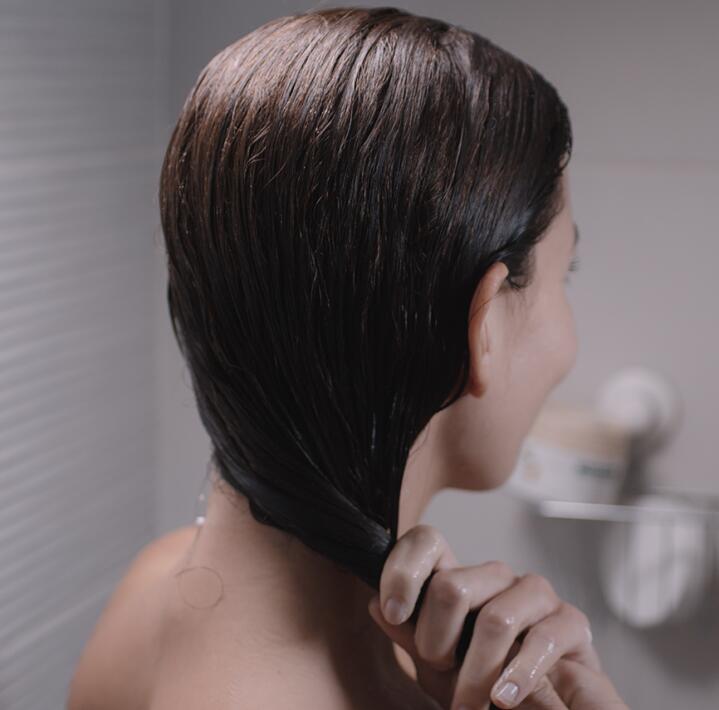
Finding the solution to greasy hair
I have greasy hair, what can I do about it? Greasy hair doesn't mean your hair is dirty, the real cause is sebum production. Fortunately, nature has the solution.
How to recognise a greasy scalp
To diagnose an oily scalp, look in a mirror and run your hand through your hair. Is your hair oily, shiny, weighed down or difficult to style?
If so, you have an oily scalp. And because scalp issues affect the hair too, your hair is also oily. Oily scalps are caused by an overproduction of sebum, called hyperseborrhea. Although sebum is essential because it acts as a lubricant and protects the hair against external aggressions, in excess it suffocates the skin and roots. This is sometimes accompanied by itching and even dandruff (oily, not dry dandruff) due to an imbalance of the scalp and the proliferation of bacteria that weakens the skin. An oily scalp is more than just a "bad hair day", it can be a real source of discomfort.
What are the causes of an oily scalp?
There are different causes that can aggravate or accentuate excess sebum.
When sebaceous glands overreact they produce excess sebum that cannot be absorbed by the scalp, causing the roots to become greasy. It is therefore necessary to investigate the causes of this imbalance.
The main cause: hormonal imbalance (linked to puberty, stress or a pathology), which causes the sebaceous glands to overstimulate therefore producing too much sebum and perspiration.
Alternatively, it may be that aggressive agents are forcing the scalp to produce excess sebum to protect itself. So beware of pollution and excessive heat (from heat styling or the sun) that can dry the skin causing it to secrete more sebum. The use of aggressive products or chemical treatments (such as certain dyes) can also be the cause behind oily hair.
What is sebum?
Sebum is the hair’s protective layer, also known as the hydrolipidic film. This barrier is found on nearly every surface of our body. It serves to protect against external aggressions while also helping with water retention.
Sebum is responsible for giving hair its shine. But when seborrhea (the excessive secretion of sebum) occurs, the scalp becomes oily. Fortunately, there are solutions to combat this phenomenon.
Good habits
5 tips to say goodbye to greasy hair
- By kind to your scalp: massage it with your fingertips and gently brush your hair to help activate microcirculation and bring sebum to the surface.
- Use dry shampoo between washes to avoid washing your hair too often.
- Use a gentle, non-sebogenic shampoo (which doesn't contribute to sebum production)
- Let your hair dry naturally as much as possible
- Avoid touching your hair.

Quick routine for when you don’t have time
To give your hair a healthy appearance, use the Dry Shampoo with Nettle to keep your hair clean and lightweight while also avoiding over-washing it.
OILY HAIR SOLUTIONS
What’s better for getting rid of sebum? Citron or nettle?
You have normal hair but it tends to get greasy pretty quickly. This is probably due to small daily aggressions: pollution, limestone or stress for example.
Traditionally used for its toning and purifying properties, citron restores bounce and shine to your hair as well as leaving it feeling cleaner for longer.
When oily roots bother us we tend to wash our hair too much, sometimes every day. Nettle is the perfect active ingredient. Thanks to its deep cleansing powers you’ll be able to cut back on washes and gain peace of mind.
The powers of nettle for oily hair
Klorane botanists have used organic nettle in a range of natural and eco-responsible haircare products that lastingly rebalance the scalp. Urtica dioica L. has been selected for its richness in active ingredients with sebum-regulating properties. In fact, nettle extract reduces sebocyte lipid production by 91%. Nettle extract thus helps diminish the production of sebum, the cause of greasy roots.

How to wash your hair (the right way)
Discover our tutorial on how to properly wash your hair. The trick is to massage your head!

Playing YouTube videos requires the use of cookies in order to offer you targeted advertising based on your browsing For more information, please visit YouTube's « cookie » policy.
You have rejected Youtube's cookies and therefore you cannot view the video.
You can change your choices by clicking on « Cookie Settings » and accept Youtube's cookies to enable the video.
You can change this setting and withdraw your consent at any time.

How to build a haircare routine that works for you
A good haircare routine should have 3 steps, after identifying the needs of your scalp and hair lengths.
NEWSLETTER
Nature often has the solution...
All our tips for taking care of yourself with natural products.

